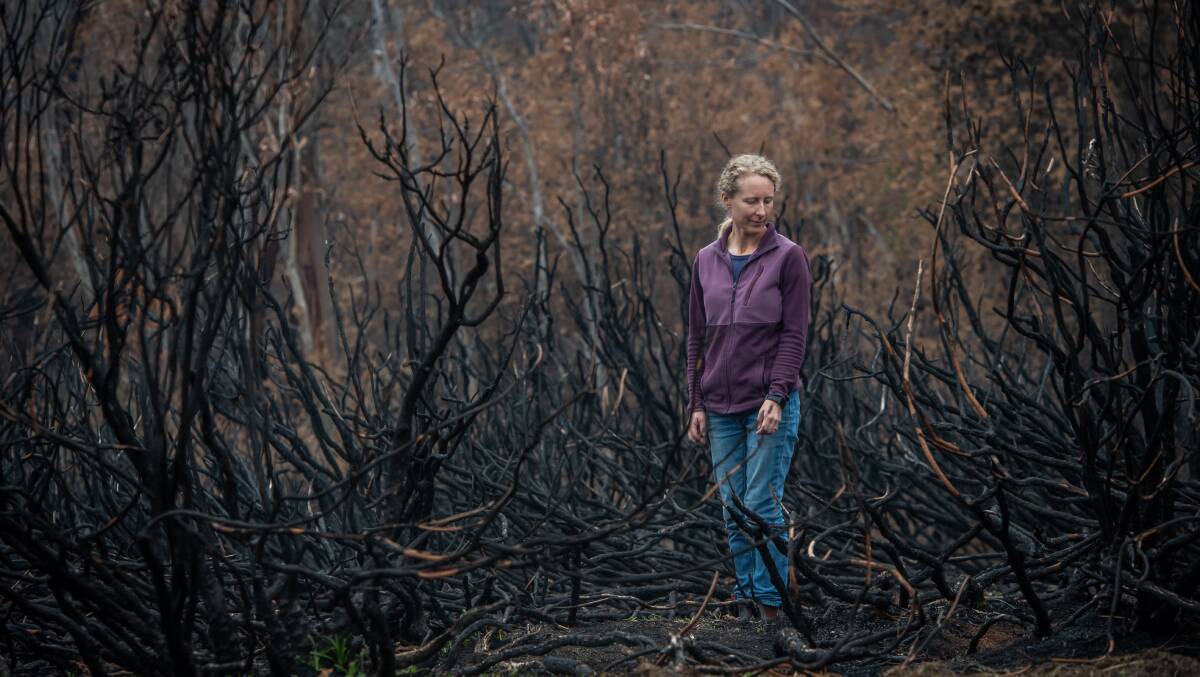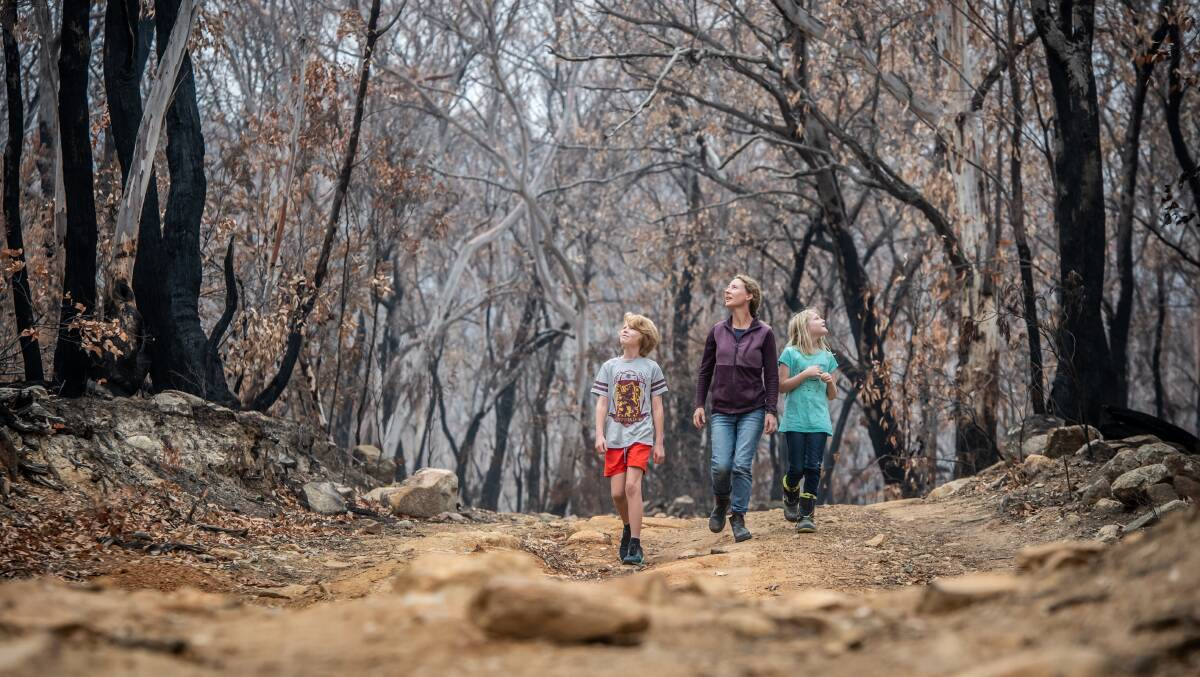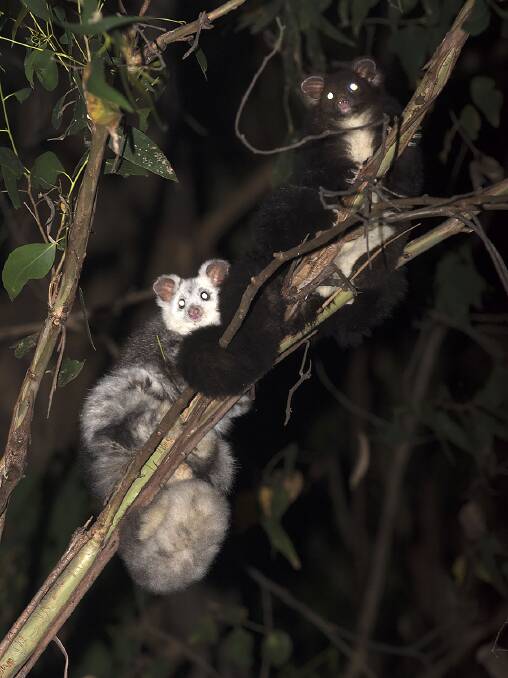High in the trees on Karen Ford's Forbes Creek property lives what can only be described as a possum crossed with a polar bear.
Subscribe now for unlimited access.
or signup to continue reading
The Australian National University nutritional ecologist and her family have spent many nights out spotlighting, looking to catch a glimpse of the greater gliders that have also made their home on the fringe of the Tallaganda National Park, south-east of Canberra.

Dr Ford, who studies eucalyptus leaves and specialist herbivores, says it is one of the densest populations she has ever seen. Or was.
Since the North Black Range bushfire swept through last year, the only greater gliders Dr Ford has seen are dead ones. She has found 15 of them so far.
It's been estimated more than 1 billion animals have died in the fires since September 2019, with millions of hectares burnt across south-eastern Australia.
Environment Minister Sussan Ley warned the population status of koalas could even be changed from vulnerable to endangered due to the extent of the devastation.
But little has been said about the threat to greater gliders, which also feed almost exclusively on eucalyptus leaves and buds.
The gliders Dr Ford found were unburnt, and appear to have died from starvation or dehydration.
It highlights the difficulties in helping sensitive populations to recover from bushfires.
"People have no idea often that there's another animal like a koala that relies on eucalypt leaves," Dr Ford said.
Australian National University conservation biologist Professor David Lindenmayer, who has studied the marsupials extensively, said the features that made the greater glider such a magnificent creature also made them incredibly vulnerable.

"The greater glider is basically a small gliding koala, if you can imagine that," he said.
"It's sometimes called a ringtail possum in drag. It's basically got this big fluffy coat of fur, which is incredible for quite a small body, so it's quite heat sensitive."
Greater gliders were already declining significantly before the fires, as they are particularly susceptible to the effects of logging and climate change.
"Now with this additional fire across a huge part of its habitat we know it's in massive trouble," Professor Lindenmayer said.
The Coalition government has put up $50 million from its $2 billion recovery fund to help wildlife ravaged by fire to recover.
But the World Wide Fund for Nature (WWF) said this was nowhere near enough.
Before the 2019 budget, WWF-Australia called for the federal government to spend $140 million per year to establish predator-free safe havens for wildlife in key locations on mainland Australia, as well as $170 million a year setting up wildlife corridors and $250 million a year on helping threatened species to recover. That request was ignored.
The organisation says only five cents out of every $100 spent by the federal government is used to preserve Australia's unique biodiversity - the lowest proportion in more than a decade, and down 37 per cent on 2013 levels.
WWF-Australia chief executive Dermot O'Gorman said government needed to heed the advice of ecologists about the level of funding needed to help native flora and fauna recover.
"There is no doubt that long-term, fully funded recovery programs give fire-prone species a greater chance at bouncing back post fires," Mr O'Gorman said.

But money is only part of the equation.
While the Australian bush is extremely fire-prone, the scale and intensity of these fires are unlike any before them, Monash University ecology professor Melodie McGeoch said.
"Yes, individual Australian vegetation systems are adapted to fire, however it's not just burning that is the issue," Professor McGeoch said.
"It's the area burnt, it's how often burns happen, it's the time of year that a particular landscape or vegetation type burns, and it's the temperature of the fire.
"All four of those things impact the ability of a particular forest, grassland, bog, for example, to recover from fire."
The drought and rising temperatures have made the fires this season even more extreme.
"It just means that the consequences of these fires are more severe for the areas that are being burned and potentially also not the most appropriate type of fire for the areas being burned."
This is a particular problem in the Australian alps, where three fires recently merged into what was described as a megablaze, hundreds of thousands of hectares in size.
The fragile ecosystem was already under pressure from feral horses and deer. Now it is burning for the third time in 20 years from fires far hotter than before.
"Alpine country is adapted to being burnt every 50 to 100 years," Monash University professor and Global Plant Council president Ros Gleadow said.
"Snow gums in the alpine region may not survive this latest assault, having already endured the devastating fires that swept across the region in 2003 and 2007."
Making things worse is the persistent dry conditions, UNSW professor of conservation biology and ecosystem restoration Mike Letnic said.
"Many species would have been at low points in their population cycles due to drought," Professor Letnic said.
"The fires would have caused further reductions for many species."
READ MORE:
Species with a restricted range - like the mountain pygmy possum and Wollemi pines - face an even greater threat, Professor Letnic said.
It makes areas that have not burnt even more precious.
However, all is not lost. Already green shoots are emerging from the bushfire scar.
In a secret operation, firefighters managed to save the last grove of Wollemi pines from the Gospers Mountain megafire.
And Professor Lindenmayer has witnessed first-hand how quickly species can spring back under the right conditions.
In 2003, National Geographic cancelled a planned trip to the Booderee National Park in the Jervis Bay Territory because a bushfire had ripped through the area.
Professor Lindenmayer and his team went out anyway, and saw many animals had in fact survived.
"One of our volunteers - a wonderfully quintessentially Australian woman - just said to me, 'f--king National Geographic, these are the f--king results, these animals are still here'," Professor Lindenmayer said.
"Some of these environments are badly damaged, yes, no doubt, but they're not destroyed. And we only understand the recovery process by actually monitoring it through time."
Australia shut down its long-term Ecological Research Network in 2017, which Professor Lindenmayer called "shortsighted".
"Long-term work has always been considered the Cinderella science, you know, shunned and rejected," he said.
"Getting away collecting the numbers, year after year after year to understand the system is not as sexy as building a massive telescope or a new satellite.
"But we're never going to learn about how to live in this country, and how to deal with fire, if we don't collect the data to inform what's going on."
For the greater gliders that may have survived on Dr Ford's property, this void in long-term research means it is unclear how well or how long epicormic growth - those green sprouts - can sustain animals.
"There's not really been any work done on that at all, about how good a food source it is," Dr Ford said.
"There's probably higher protein in the leaves, which is good for animals, but ... often new leaves like that are more toxic to animals as well, because the trees try to defend them from being eaten so they can have enough leaves to grow."
There are pockets of trees with unburnt canopy on her property, which gives her hope some animals may be clinging on.
She has been putting out donated fruits and vegetables, just in case, and heading out at night with a spotlight, hoping to see some eyes shining back at her in the dark.


